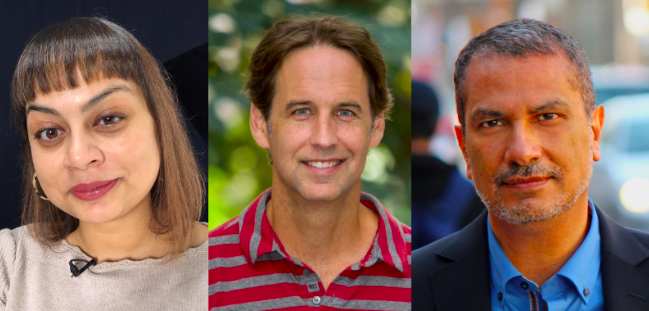Following the resignations of the former chair and associate chair, RSJ’s new interim leaders are working towards restoring and rebuilding trust among students

Ryerson School of Journalism’s (RSJ) newly appointed interim co-chairs Asmaa Malik and Gavin Adamson have released a list of five measurements to guide the school’s renewed commitment to meeting students’ needs.
In an email sent to the program’s faculty and students last Wednesday, Malik and Adamson outlined five measures intended to rebuild trust among students. With the support of RSJ’s newly appointed transformation lead, Prof. Kamal Al-Solaylee, the school will focus on the fundamental role of equity and inclusion in the future of journalism education.
“I see the transformation plan as a lot more than just a curriculum (change)… but where students don’t have to advocate for their humanity, or their worth, to the administration,” says Al-Solaylee.
These five measures have been introduced in response to outcry from students and alumni expressing concerns with the school’s leadership. In particular, they say the school has not provided effective support for Black, Indigenous, people of colour and the LGBTQ2S+ community.
Following the resignation of former chair Janice Neil and associate chair Lisa Taylor, a call to action was made through an open letter by Ryerson journalism students addressing concerns that the school has “contributed to an unsafe learning environment.”
The open letter stated areas of concerns within the program including the failure to represent and support Black, Indigenous, people of colour (BIPOC) students, as well as the failure to foster an environment that protects students who are a part of LGBTQ2S+ communities.
It also provided a list of ways the school can improve on its mental health resources, such as creating a connection between RSJ and “Ryerson-affiliated therapy resources” along with affiliations with Consent Comes First to provide support for students who have suffered from sexual violence. It also asked for the implementation of de-escalation, mental health and empathy training for the administration.
The first priority on the list of commitments provided by Malik and Adamson is a “permanent student equity task force.” According to them, this task force will consist of four elected members from both undergraduate and graduate students. Members will be collaborating with students and faculty on initiatives to address critical equity concerns inside and outside the classroom. The members will receive an honorarium for their contributions.
“There’s a need for more transparency,” Malik says. “One of the hopes with the student task force is that… they (will) collaborate with us on initiatives that will help them and that will help us.”
For Adamson, the student equity task force is meant to help the journalism school be better equipped to understand student needs and immediately implement plans of action requested by students.
“The student equity task force is critical,” Adamson says, adding that the direct line of communication between students and faculty will hopefully result in immediate action for students’ concerns and needs moving forward.
Al-Solaylee, who was the school’s undergraduate director between 2011 and 2014, says the role of journalism schools in 2021 needs to be redefined, especially in a time of social unrest for BIPOC communities.
“I want to look at it much more holistically than just some courses and some measures. I want us to have a serious conversation about journalism and journalism education and the role that journalism schools play, in my opinion, sometimes being an incubator for a lot of the things that are wrong in the industry,” says Al-Solaylee.
He says the administration needs to focus on conversations that are being had between faculty and students. Journalism schools need to do a better job of making sure students are understanding the way free speech is not applied equally, Al-Solaylee says, and the ways in which some students’ words are seen as acceptable while others are not, based on their race or sexual orientation.
Malik and Adamson say two faculty members will soon be hired to better reflect the “changing student demographics and offer a diversity of experiences and perspectives on journalism and its practice.” They also intend to redesign existing RSJ curriculums.
Adamson says the planning for an updated curriculum will begin this summer. They intend for changes to be made to ensure best practices reporting on marginalized communities are being taught early on, rather than in the third and fourth years.
Part of creating a safe environment for students means hiring more instructors and higher-up faculty who are from marginalized communities, says Malik, including those who have diverse lived experiences and have different approaches to practising journalism.
It’s about “creating a classroom environment where (those instructors) can help create a space where people feel respected,” says Malik, adding it can also make space to centre voices from the margins.
Last year, Carleton University’s School of Journalism also released 30 calls to action, stating the school “fails to support students who identify as Black, Indigenous and people of colour, perpetuating systemic discrimination and deterring them from pursuing careers as journalists.”
Malik and Adamson say they have been in conversation with Susan Harada, who is on sabbatical from Carleton and also the chair of J-Schools Canada. They are talking about joint action plans focused on building more equitable j-schools nationwide.
“It’s really about listening,” says Malik. “That’s a lot of what we’ve been doing in the last few weeks… active listening and communicating better and collaborating on ways that we can all move forward together as a school (where) people can feel like everyone’s looking out for each other’s interests.”
This article may have been created with the use of AI tools such as
